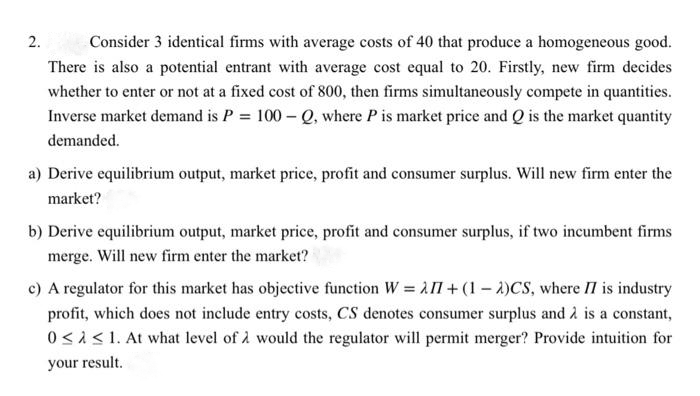2. Consider 3 identical firms with average costs of 40 that produce a homogeneous good. There is also a potential entrant with average cost equal to 20. Firstly, new firm decides whether to enter or not at a fixed cost of 800, then firms simultaneously compete in quantities. Inverse market demand is P = 100-Q, where P is market price and Q is the market quantity demanded. a) Derive equilibrium output, market price, profit and consumer surplus. Will new firm enter the market? b) Derive equilibrium output, market price, profit and consumer surplus, if two incumbent firms merge. Will new firm enter the market? c) A regulator for this market has objective function W = AII+(1-2)CS, where II is industry profit, which does not include entry costs, CS denotes consumer surplus and 2 is a constant, 0 ≤ ≤ 1. At what level of would the regulator will permit merger? Provide intuition for your result.
2. Consider 3 identical firms with average costs of 40 that produce a homogeneous good. There is also a potential entrant with average cost equal to 20. Firstly, new firm decides whether to enter or not at a fixed cost of 800, then firms simultaneously compete in quantities. Inverse market demand is P = 100-Q, where P is market price and Q is the market quantity demanded. a) Derive equilibrium output, market price, profit and consumer surplus. Will new firm enter the market? b) Derive equilibrium output, market price, profit and consumer surplus, if two incumbent firms merge. Will new firm enter the market? c) A regulator for this market has objective function W = AII+(1-2)CS, where II is industry profit, which does not include entry costs, CS denotes consumer surplus and 2 is a constant, 0 ≤ ≤ 1. At what level of would the regulator will permit merger? Provide intuition for your result.
Economics: Private and Public Choice (MindTap Course List)
16th Edition
ISBN:9781305506725
Author:James D. Gwartney, Richard L. Stroup, Russell S. Sobel, David A. Macpherson
Publisher:James D. Gwartney, Richard L. Stroup, Russell S. Sobel, David A. Macpherson
Chapter24: Price-searcher Markets With High Entry Barriers
Section: Chapter Questions
Problem 7CQ
Related questions
Question
Please no written by hand solution

Transcribed Image Text:2.
Consider 3 identical firms with average costs of 40 that produce a homogeneous good.
There is also a potential entrant with average cost equal to 20. Firstly, new firm decides
whether to enter or not at a fixed cost of 800, then firms simultaneously compete in quantities.
Inverse market demand is P = 100-Q, where P is market price and Q is the market quantity
demanded.
a) Derive equilibrium output, market price, profit and consumer surplus. Will new firm enter the
market?
b) Derive equilibrium output, market price, profit and consumer surplus, if two incumbent firms
merge. Will new firm enter the market?
c) A regulator for this market has objective function W = I1+(1-2)CS, where II is industry
profit, which does not include entry costs, CS denotes consumer surplus and is a constant,
0< < 1. At what level of would the regulator will permit merger? Provide intuition for
your result.
Expert Solution
This question has been solved!
Explore an expertly crafted, step-by-step solution for a thorough understanding of key concepts.
This is a popular solution!
Trending now
This is a popular solution!
Step by step
Solved in 2 steps

Knowledge Booster
Learn more about
Need a deep-dive on the concept behind this application? Look no further. Learn more about this topic, economics and related others by exploring similar questions and additional content below.Recommended textbooks for you

Economics: Private and Public Choice (MindTap Cou…
Economics
ISBN:
9781305506725
Author:
James D. Gwartney, Richard L. Stroup, Russell S. Sobel, David A. Macpherson
Publisher:
Cengage Learning

Microeconomics: Private and Public Choice (MindTa…
Economics
ISBN:
9781305506893
Author:
James D. Gwartney, Richard L. Stroup, Russell S. Sobel, David A. Macpherson
Publisher:
Cengage Learning

Economics: Private and Public Choice (MindTap Cou…
Economics
ISBN:
9781305506725
Author:
James D. Gwartney, Richard L. Stroup, Russell S. Sobel, David A. Macpherson
Publisher:
Cengage Learning

Microeconomics: Private and Public Choice (MindTa…
Economics
ISBN:
9781305506893
Author:
James D. Gwartney, Richard L. Stroup, Russell S. Sobel, David A. Macpherson
Publisher:
Cengage Learning